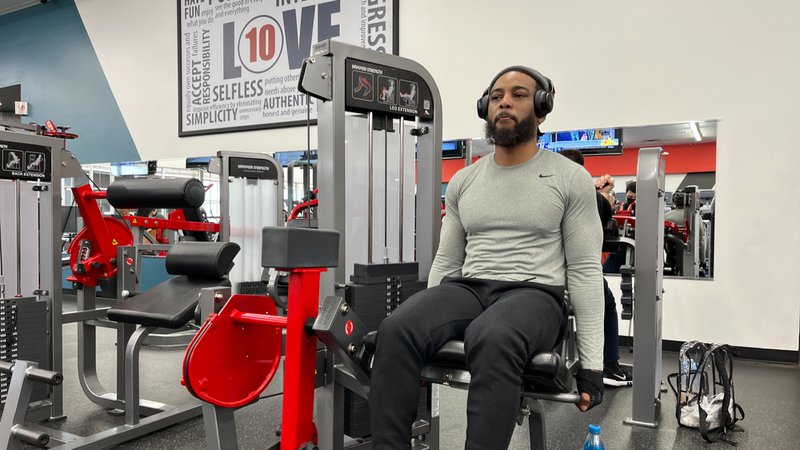
Want to get strong, feel better, and stay on budget? Strength training is one of the best ways to build muscle, boost confidence, and stay healthy for life—and you don’t need expensive gear or a big paycheck to start. If you’re new to weights, don’t worry. Let’s explore simple, practical steps to help you begin. We’ll cover what you need, what works, and how to build strength without fear.
Key Takeaways:
- Strength training supports muscle mass, bone strength, balance, cardiovascular health, and longevity.
- It reduces body fat and supports the management of health concerns like heart conditions and type 2 diabetes.
- Mental health benefits include improved mood, reduced stress, better sleep, and sharper thinking.
- Strength training works at any age and can help prevent age-related muscle loss.
- Beginners should train 2–3 times/week using full-body routines with breaks in between.
- Start light (10–15 reps with proper form); increase load by about 5% as you progress.
- Focus on technique before increasing weight to avoid injury and see steady improvements.
- Use dumbbells, resistance bands, or body weight—there’s no need for a gym membership.
- Begin with dynamic warm-ups and finish with stretching.
- Track workouts with apps or journals; aim for steady effort and realistic schedules.
- Trainers can provide helpful input and improve technique safely.
- Women won’t get bulky from lifting; it helps with fat loss, muscle tone, and healthy aging.

How to Start Strength Training: A Beginner’s Guide to Building Strength, Confidence, and Longevity
Learning how to start strength training can feel like a big step, especially if you’ve never lifted weights or worked out consistently before. However, with the right guidance, a simple routine, and the right mindset, anyone—at any age or fitness level—can begin building strength and improving well-being.
From improving your posture and protecting your bones to boosting mental focus and energy, strength training lays the foundation for a healthier, stronger life. Moreover, it doesn’t take hours each day or expensive equipment to get started.
So, let’s explore how to begin strength training in a way that’s safe, effective, and empowering.
Strength Training Improves Health and Longevity at Any Age
One of the most compelling reasons to learn how to start strength training is the wide range of health benefits it delivers, even after just a few weeks. According to the Mayo Clinic, strength training not only improves strength, balance, and bone density but also reduces the risk of falls, fractures, and chronic diseases.
Initially, each workout stimulates muscle growth through small tears in the fibers, which subsequently repair stronger than before. Over time, this process improves posture, mobility, and everyday performance, such as lifting groceries or climbing stairs.
As we age, muscle naturally declines in a process called sarcopenia. However, strength training effectively slows or even reverses this decline. With just two to three sessions per week, you can increase bone strength, protect joints, and support independence for years to come.
Even better, strength training not only supports cardiovascular health but also boosts your metabolism, thereby helping you manage weight and reduce risks linked to heart disease and type 2 diabetes.
Strength Training Also Boosts Mental Well-Being
While physical benefits are easier to see, the mental rewards of strength training are just as important. Regular training not only helps reduce anxiety but also eases symptoms of depression and improves sleep, all by supporting hormone and brain health.
Furthermore, after a strength session, your body releases endorphins—natural mood boosters that leave you feeling calmer and more focused. Consequently, better sleep and reduced stress follow, which can positively affect every part of your life.
In fact, many people report feeling more confident after just a few weeks of strength training. Additionally, improved body awareness, posture, and coordination often lead to a sense of empowerment that carries into work, home, and relationships.
Strength Training Is Safe to Start at Any Age
Worried it’s too late to begin? It’s not. Whether you’re 25 or 65, it’s never too early—or too late—to start building strength.
Muscle loss begins around age 30, but the good news is that even older adults can regain strength quickly. The National Institute on Aging confirms that strength training improves energy, mobility, and bone health in older adults. Many people regain confidence in daily tasks like walking, lifting, or even gardening within just a few weeks.
So whether your goal is to age well, stay active, or simply feel stronger in your everyday life, strength training is a smart investment in your long-term health.
The Equipment You Need to Begin Is Simple and Affordable
You don’t need a full gym setup to get started. In fact, basic tools or even your own body weight are often enough.
Dumbbells Are a Great Starting Point
Dumbbells are versatile, easy to control, and ideal for beginners. Moreover, they allow you to press, curl, squat, and row—thereby reaching most major muscle groups in one compact set.
To begin, start with weights between 5 and 15 pounds. Aim for 8–15 reps per set. However, if you can easily lift more than 15 reps, it’s time to increase the weight slightly.
Try Resistance Bands or a Stability Ball
Resistance bands are lightweight, portable, and cost-effective. They’re fantastic for rows, squats, shoulder presses, and core work. Additionally, you can add a stability ball if you'd like to build balance and support your core.
In particular, these tools are especially helpful for at-home workouts or travel routines.
Machines and Free Weights Both Have Benefits
Moreover, machines are often ideal for beginners because they guide your movement and reduce the risk of injury. They’re great for exercises like leg presses, chest presses, or seated rows.
On the other hand, free weights, like dumbbells or kettlebells, engage more muscles and develop balance and coordination. Therefore, it’s a good idea to start with machines if you're new, then gradually add free weights as your form improves.
You Can Start Strength Training Without Equipment
Great news: you don’t need to buy anything to begin. Bodyweight exercises such as squats, lunges, pushups, and planks are incredibly effective.
To start, try these:
- Wall Pushups – This exercise helps build upper-body strength safely.
- Bodyweight Squats – These will strengthen your legs and hips effectively.
- Dead Bugs – Additionally, this move strengthens your core and coordination.
- Lunges – Furthermore, lunges improve balance and lower-body control.
By incorporating these moves, you'll learn how to start strength training with zero equipment. Once you feel confident, you can gradually add resistance with dumbbells or bands.A Simple Beginner Strength Training Plan to Follow
If you're just beginning, start with 2 to 3 full-body sessions per week. Rest for at least one day between workouts to allow for recovery.
Sample Beginner Workout Routine
- Wall Pushups – Start with 2 sets of 10–15.
- Bodyweight Squats – Next, perform 2 sets of 10.
- Resistance Band Rows – Then, complete 2 sets of 10.
- Shoulder Press (Dumbbells) – Afterward, do 2 sets of 8–12.
- Seated Leg Curls (Band) – Following that, perform 2 sets of 10.
- Crunches or Dead Bugs – Finally, end with 2 sets of 10–15.
Remember to take 30–60 seconds of rest between sets. Focus on form rather than speed. If something hurts, stop and make adjustments.
This routine effectively works your chest, legs, back, shoulders, and core—therefore, covering your full body in just 30–40 minutes. To build a custom plan or explore new exercises, check out the 10 Fitness Training Options.
Choosing the Right Weight to Begin With
New to lifting? The most common question is: “How much should I lift?”
Use the 10–15 Rep Rule
Pick a weight you can lift with good form for 10–15 reps. If you’re shaking, twisting, or struggling by rep 8, it’s too heavy. If you breeze through 20 reps, it’s too light.
Once 15 reps feel easy, increase the weight by about 5%, or move up one dumbbell size.
Your goal: finish your set feeling challenged but still in control.
Signs Your Weight Is Right
Still unsure? Here’s what to look for:
- Last 2 reps feel tough, but doable
- Form stays clean—no twisting or rushing
- You recover in 30–60 seconds
- You feel muscle fatigue, not joint pain
Avoid pushing through sharp pain or discomfort. A proper challenge should feel like a "burn," not a strain.
Track Your Progress to Stay Motivated
Progress in strength training isn’t always visible. That’s why it helps to track your reps, weights, and how you feel after each session.
Use a notebook, app, or spreadsheet. Over time, you’ll notice:
- Increased reps
- Heavier weights
- Shorter rest times
- Better posture and energy
These small wins build real confidence, especially when motivation dips.
Strength Training Is a Long-Term Investment in Health
Once you’ve learned how to start strength training, it's important to stick with it. Consistency is where the magic happens.
Here’s a sample weekly schedule:
- Monday – Strength (full-body)
- Wednesday – Strength + light walking
- Friday – Strength
- Saturday – Optional recovery stretch or foam rolling
This routine gives you 48 hours between sessions for recovery, which is when muscles rebuild stronger.
If you’re ready to advance, consider adding a fourth day or exploring training splits. For personalized support, view Group Training Options or Personal Training Services.
Final Thoughts on Starting Strength Training Safely
Learning how to start strength training is about more than building muscle—it’s about building a stronger, more confident life.
Start with simple tools. Focus on form. Train two to three days per week. Track your progress, rest when needed, and move at your own pace.
Strength transforms how you move, how you feel, and how you live. And best of all, you can begin right now.
Ready to Start Strength Training? Find a Gym That Supports You
Take the First Step with 10 Fitness
Looking to begin your strength journey in a welcoming, supportive environment? Find a 10 Fitness near you and take advantage of state-of-the-art equipment, expert trainers, and beginner-friendly classes. Whether you’re brand new or returning after a break, 10 Fitness makes it easy to get started. Your strength story begins with one visit—make it today!

